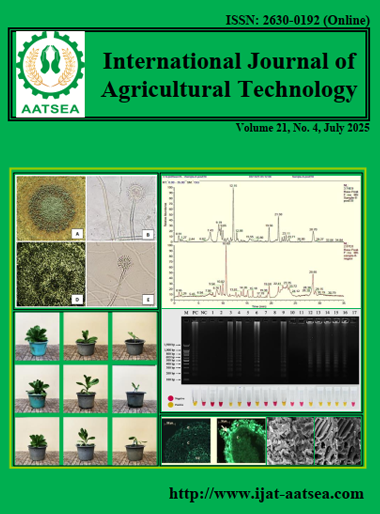Postharvest treatment to control mycotoxin in coffee bean using radio frequency
Main Article Content
Abstract
Analytical results indicated the presence of ochratoxin A (OTA), aflatoxin B1, and total aflatoxins in all coffee bean samples. The concentration levels ranged from non-detectable to 46.40 μg/kg for OTA, 18.73–50.44 μg/kg for aflatoxin B1, and 10.18–31.75 μg/kg for total aflatoxins. All coffee bean samples were contaminated with both total aflatoxins and aflatoxin B1. Radio frequency (RF) treatments evaluated for the reduction of mycotoxins in coffee beans showed that applying RF at 55.00 °C for 180 seconds did not reduce the percentage of inoculated coffee beans to the same level as the non-RF-treated samples. However, high moisture content was associated with increased levels of ochratoxin A, aflatoxin B1, and total aflatoxins.
Article Details

This work is licensed under a Creative Commons Attribution-NonCommercial-NoDerivatives 4.0 International License.
References
Agricultural Commodity and Food Standards (2018a). Arabica green coffee: Thai Agricultural Standard TAS 5701-2018. Retrieved from https://www.acfs.go.th/standard/download/ Arabica_coffee_bean_2561.pdf
Agricultural Commodity and Food Standards (2018b). Robusta green coffee: Thai Agricultural Standard TAS 5700-2018. Retrieved from https://www.opsmoac.go.th/saraburi-manual-files-431491791810
Al-Abdalall, A. H. A. and Al-Talib, E. A. (2014). Aflatoxin and Ochratoxin Production in Ground Coffee During Storage. Canadian Journal of Pure and Applied Sciences, 8:2825-2836.
Bayman, P. and Baker, J. L. (2006). Ochratoxins: A global perspective. Mycopathologia, 162: 215-223. DOI: https://doi.org/10.1007/s11046-006-0055-4
Bokhari, A. M. (2007). Mycotoxins and Toxigenic Fungi in Arabic Coffee Beans in Saudi Arabia. Advances in Biological Research, 1:56-66.
Cui, M., Sun, W., Xia, L., Wang, M., Cao, Y. and Wu, Y. (2020). Effect of radio frequency heating on the mortality of Rhizopertha dominica (F.) and its impact on grain quality. Journal of Stored Products Research, 89:101695. DOI: https://doi.org/10.1016/j.jspr.2020.101695
Daou, R., Joubrane, K., Maround, R., Khabbaz, L. A., Ismail, A. and Khoury, A. E. (2021). Mycotoxins: Factors influencing production and control strategies. AIMS Agriculture and Food, 6:416-447. DOI: https://doi.org/10.3934/agrfood.2021025
Djadjiti, N., Aziz1, A. M., Esther, K. O. and Dane, S. (2020). Isolation and Identification of Fungal Pathogens Contaminating Some Coffee Powder Marketed in the City of Abuja. Journal of Research in Medical and Dental Science, 8:172-175.
European Commission Regulation (2006). Commission regulation (EC) no. 1881/2006 of 19 December 2006 setting maximum levels for certain contaminants in foodstuffs. Official Journal of the European Union, L364:5-18.
Ismaiel, A. A. and Papenbrock, J. (2015). Mycotoxins: Producing Fungi and Mechanisms of Phytotoxicity. Agriculture, https://doi.org/10.3390/agriculture5030492. (Accessed 21 March 2021). DOI: https://doi.org/10.3390/agriculture5030492
Komarov, V., Wang, S. and Tang, J. (2005). Permittivity and measurement. In: Chang K (ed) The Wiley encyclopedia of RF and microwave engineering, vol 4. John Wiley & Sons, Inc. pp.3693-3711. DOI: https://doi.org/10.1002/0471654507.eme308
Kuntawee, S. and Akarapisan, A. (2015). Isolation and identification of Aspergillus species producing Ochratoxin A in Arabica coffee beans. Journal of Agricultural Technology, 11:1235-1242.
Liu, Y., Yamdeu, J. H. G., Gong, Y. Y. and Orfila, C. (2020). A review of postharvest approaches to reduce fungal and mycotoxin contamination of foods. Comprehensive reviews in food science and food safety, pp.1-40. DOI: https://doi.org/10.1111/1541-4337.12562
Noonim, P., Mahakarnchanakul, W., Nielsen, K. F., Frisvad, J. C. and Samson, R. A. (2008). Isolation, identification and toxigenic potential of ochratoxin A-producing Aspergillus species from coffee beans grown in two regions of Thailand. International Journal of Food Microbiology, 128:197-202. DOI: https://doi.org/10.1016/j.ijfoodmicro.2008.08.005
Romer Labs (2019a). AgraQuant Aflatoxin B1 2/50 ELISA kit. Article Number COKAQ 8000 /COAKQ 8048, Romer Labs Division Holding GmbH, Tulln, Austria.
Romer Labs. (2019b). AgraQuant Ochratoxin 2/40 ELISA kit. Article Number 10002102/10002103, Romer Labs Division Holding GmbH, Tulln, Austria.
Romer Labs. (2019c). AgraQuant Total Aflatoxin 4/40 ELISA kit. Article Number 10002098/10002 099, Romer Labs Division Holding GmbH, Tulln, Austria.
Silvaa, S. A., Pereiraa, A. F. G. R., Lirab, A. N., Glóriac, M. E., Chalfound, M. S. and Batistaa, R. L. (2020). Fungi associated to beans infested with coffee berry borer and the risk of ochratoxin A. Food Control, 113:107204. DOI: https://doi.org/10.1016/j.foodcont.2020.107204
Sirinunta, A. and Akarapisan, A. (2015). Screening of antagonistic bacteria for controlling Cercospora coffeicola in Arabica coffee. Journal of Agricultural Technology, 11:1209-1218.
Taniwaki, M. H., Pitt, J. I., Copetti, M. V., Teixeira, A. A. and Iamanaka, B. T. (2019). Understanding mycotoxin contamination across the food chain in Brazil: Challenges and Opportunities. Toxins, 11:1-17. DOI: https://doi.org/10.3390/toxins11070411
United States Department of Agriculture (2020). Coffee: World markets and trade. Foreign Agricultural Service, https://apps.fas.usda.gov/psdonline/circulars/coffee.pdf. (Accessed 22 March 2021).
Zhou, L., Ling, B., Zheng, A., Zhang B. and Wang, S. (2015). Developing radio frequency technology for postharvest insect control in milled rice. Journal of Stored Products Research, 62:22-31. DOI: https://doi.org/10.1016/j.jspr.2015.03.006


